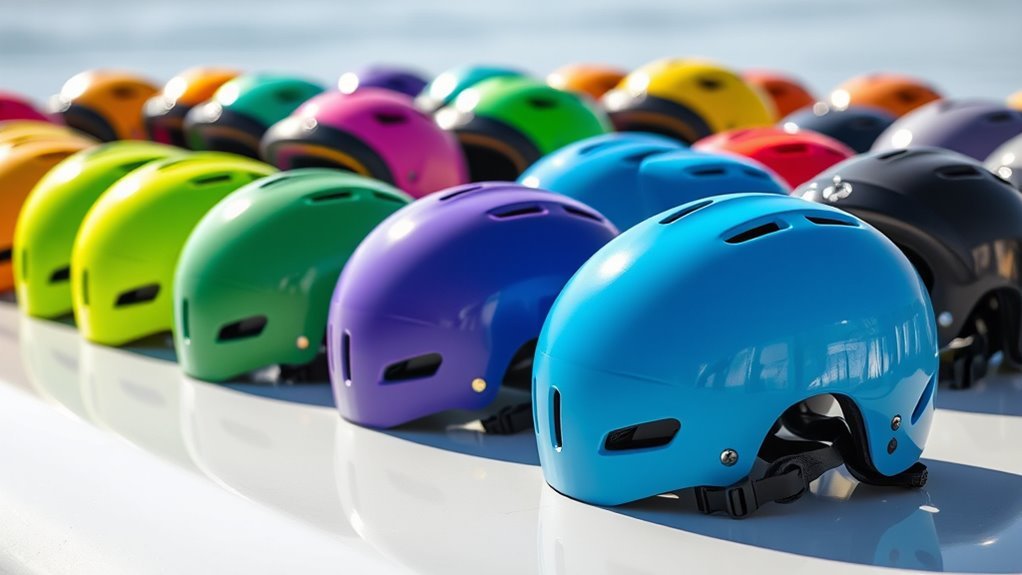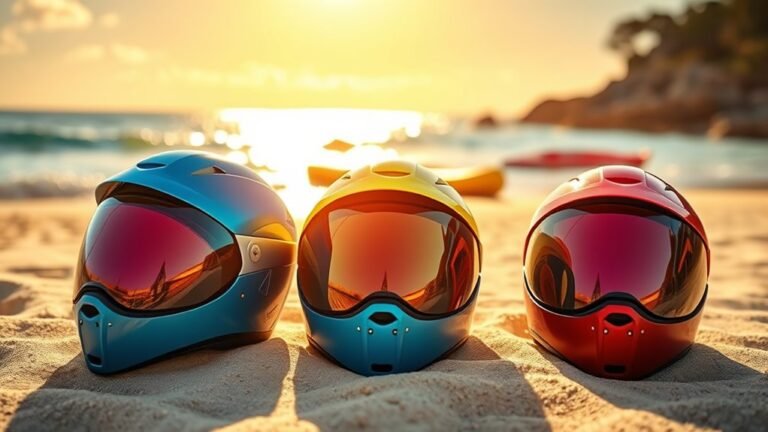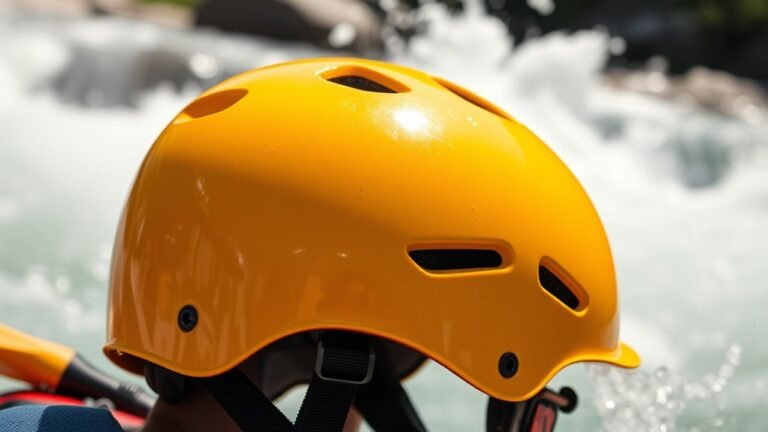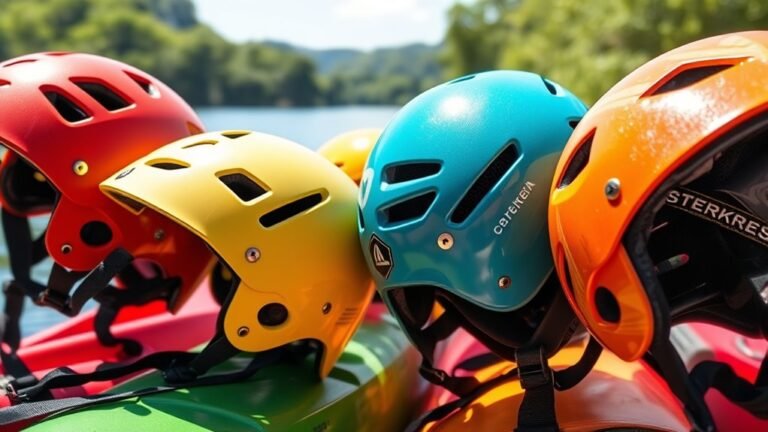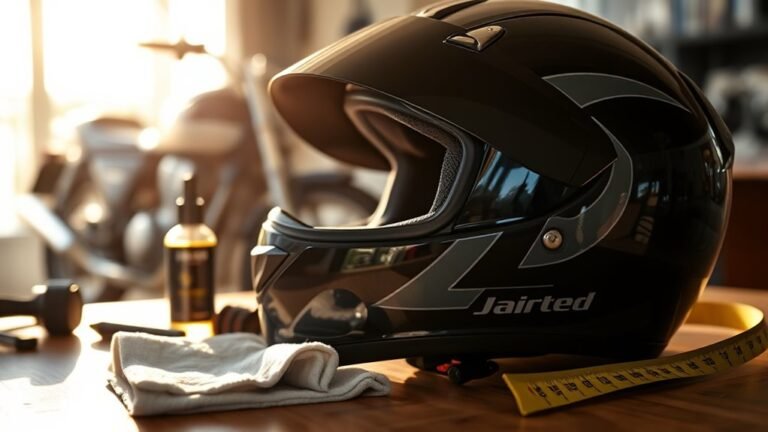Safety Standards for Water Sports Helmets
When it comes to safety standards for water sports helmets, it’s vital to know that the ASTM F2040, CE Certification, and EN 1385 verify helmets meet rigorous impact and retention tests. These standards help guarantee protection against head injuries during activities like kayaking, wakeboarding, and jet skiing. Understanding these guidelines is significant for choosing the right helmet for your needs and maximizing safety. Explore more about how to select and maintain your helmet for ideal protection.
Importance of Wearing Helmets in Water Sports
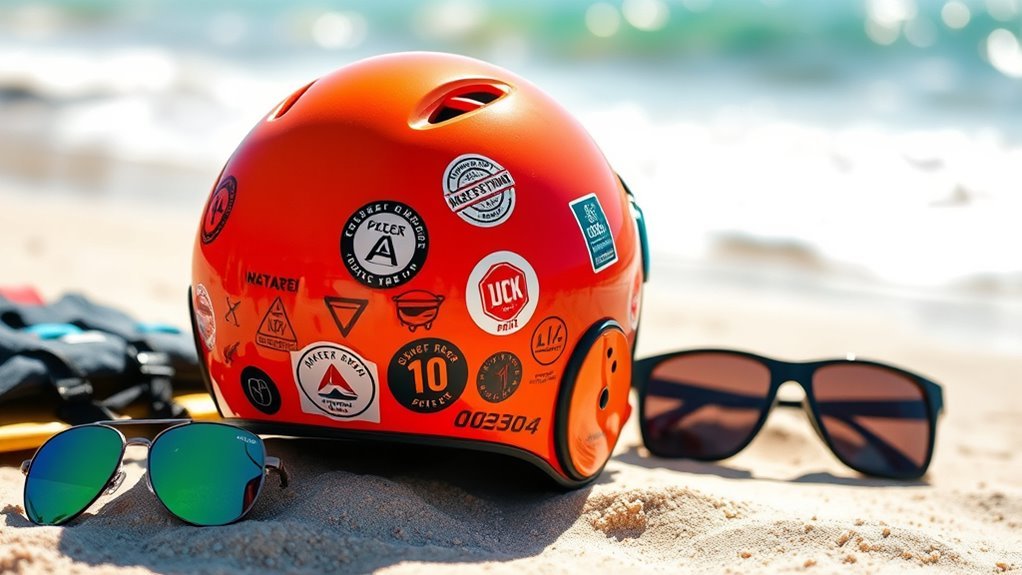
While many water sports enthusiasts might underestimate the risks involved, wearing a helmet is essential for ensuring safety during activities such as wakeboarding, kayaking, and jet skiing. The helmet benefits are significant, providing vital protection against head injuries that can occur from falls, collisions, or unexpected waves. By prioritizing injury prevention, you’re not only safeguarding your well-being but also enhancing your overall experience on the water. Helmets are designed to absorb impact, reducing the severity of injuries and allowing you to focus on enjoying your ride. Embracing this simple safety measure empowers you to explore your passion for water sports with confidence, ensuring that freedom and fun don’t come at the cost of safety. Don’t underestimate the importance of protection.
Overview of Helmet Safety Standards
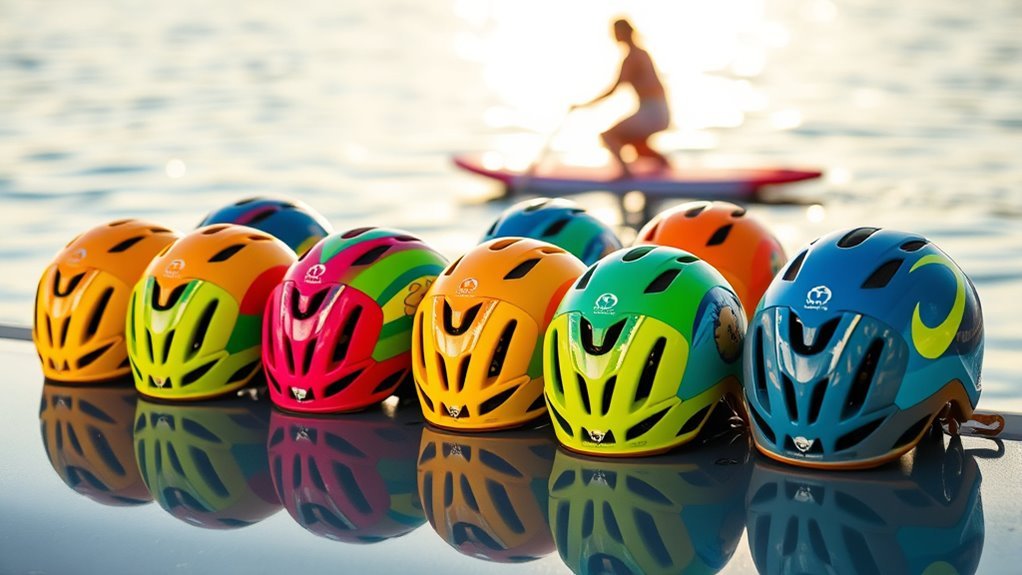
Helmet safety standards are essential for ensuring that the head protection you choose for water sports meets rigorous performance criteria. These standards involve thorough helmet testing that evaluates materials, design, and impact resistance. Manufacturers must adhere to established benchmarks, which often incorporate the latest safety innovations to enhance protection while maintaining comfort. This dynamic field is continually evolving, driven by advancements in technology and materials science. For instance, new foam technologies and improved shell designs can greatly reduce the risk of head injuries. Understanding these standards gives you the confidence to select a helmet that not only meets safety requirements but also aligns with your desire for freedom and adventure in water sports. Always prioritize safety to enjoy your activities fully.
ASTM F2040 Standard for Helmets
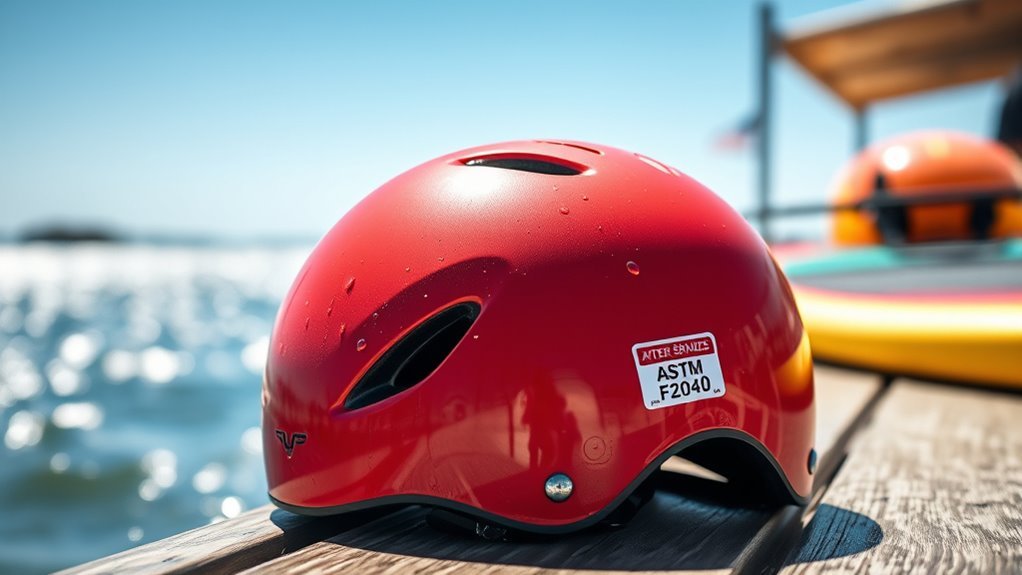
The ASTM F2040 standard serves as a critical benchmark for evaluating the safety and performance of helmets used in water sports. It sets rigorous helmet testing protocols, ensuring that products can withstand the impacts and conditions specific to activities like wakeboarding and kayaking. By adhering to this standard, manufacturers can incorporate safety innovations that enhance protection without compromising comfort and usability. Helmets tested under ASTM F2040 undergo thorough assessments, including drop tests and penetration tests, to verify their effectiveness in real-world scenarios. This standard not only fosters consumer confidence but also encourages manufacturers to continuously improve their designs. When you choose a helmet meeting ASTM F2040 criteria, you’re prioritizing your safety and embracing the freedom to enjoy water sports with peace of mind.
CE Certification and Its Significance
When it comes to ensuring adequate protection in water sports, CE certification plays a vital role in validating helmet safety. This certification signifies that a helmet meets European quality standards, providing you with confidence in its effectiveness. The CE certification benefits include rigorous helmet testing methodologies, which assess impact resistance, penetration, and retention systems under varied conditions. By choosing a CE-certified helmet, you’re not just complying with regulations; you’re prioritizing your safety and performance on the water. The certification process involves rigorous evaluations, ensuring that the helmet can withstand real-world scenarios. So, when you’re out there enjoying your freedom on the waves, you can trust that your CE-certified helmet is designed to protect you effectively.
EN 1385 Standard for Water Sports Helmets
While enjoying water sports, it’s vital to understand the EN 1385 standard, which specifically addresses safety requirements for water sports helmets. This standard guarantees that helmets provide adequate protection during your adventures on the water.
Understanding the EN 1385 standard ensures your water sports helmet offers the protection needed for safe adventures on the water.
Key aspects of the EN 1385 specifications include:
- Impact resistance: Helmets must withstand various impact forces during testing.
- Retention system: The helmet must securely fit to prevent it from being dislodged.
- Water drainage: Proper ventilation is key to enhance comfort and performance.
Understanding these helmet testing methods assures you’re choosing a product that keeps you safe while allowing you the freedom to enjoy your favorite sports. Following the EN 1385 standard guarantees that your helmet will perform as expected in the water, giving you peace of mind.
Differences Between Recreational and Professional Helmets
When comparing recreational and professional helmets, you’ll notice significant differences in design and construction. Professional helmets often feature higher impact resistance ratings and adhere to stricter usage guidelines and regulations. Understanding these distinctions is essential for ensuring your safety on the water, regardless of your skill level.
Design and Construction Variances
Recreational and professional water sports helmets exhibit significant design and construction variances that directly impact user safety and performance. Understanding these differences is vital for selecting the right helmet for your needs.
- Design Variations: Professionals often require specialized fits and aerodynamic shapes for peak performance.
- Construction Materials: Recreational helmets may use lighter, less durable materials, while professional ones incorporate advanced composites for enhanced protection.
- Weight and Comfort: Professionals prioritize lightweight designs to maximize agility, whereas recreational models focus more on comfort for longer wear.
These variances are essential to take into account when you’re choosing a helmet, as they can affect not only your safety but also your overall experience on the water. Always prioritize understanding these distinctions to guarantee you’re adequately protected.
Impact Resistance Ratings
Impact resistance ratings play an essential role in distinguishing between recreational and professional water sports helmets. Recreational helmets typically undergo less rigorous testing methods, designed to handle lower impact forces. These helmets are suitable for casual users who engage in less intense activities. In contrast, professional helmets are subjected to stringent testing protocols, ensuring they can withstand higher impact forces encountered during extreme conditions. The testing methods for these helmets often involve simulating real-life scenarios to assess their durability and protective capabilities. When choosing a helmet, you must consider these ratings, as they directly influence your safety. Ultimately, understanding the differences can empower you to make informed decisions for your water sports adventures, balancing freedom with essential safety.
Usage Guidelines and Regulations
Understanding the differences in usage guidelines and regulations between recreational and professional helmets is essential for ensuring safety in water sports. Recreational helmets often prioritize comfort and general safety compliance, making them suitable for casual use. In contrast, professional helmets must meet stringent standards, ensuring superior helmet fitting and protection during high-impact activities.
- Recreational helmets: Designed for casual users, focusing on comfort.
- Professional helmets: Must meet rigorous safety compliance standards for extreme conditions.
- Importance of proper helmet fitting: A well-fitted helmet enhances protection and performance.
Choosing the Right Helmet for Your Water Sport
When you’re gearing up for a water sport, selecting the right helmet is essential for your safety and performance. You’ll want to take into account helmet sizing and features tailored to your activity. Here’s a quick guide to help you choose:
| Sport | Helmet Features | Sizing Tips |
|---|---|---|
| Kayaking | Impact-resistant shell | Measure head circumference |
| Wakeboarding | Visor for sun protection | Try on with hair or cap |
| Jet Skiing | Ear protection | Guarantee snug fit, no movement |
| Surfing | Lightweight design | Adjust straps for comfort |
| Paddleboarding | Ventilation for airflow | Check for proper clearance |
Choosing the right helmet enhances both your freedom and safety on the water.
Maintenance and Care for Your Helmet
Although helmets are designed to withstand significant impacts, regular maintenance and care are vital to guarantee their longevity and effectiveness. You’ll want to make sure your helmet remains in top condition for your adventures. Here are some important tips:
- Helmet cleaning: Use mild soap and water to clean the exterior, avoiding harsh chemicals that could damage the material.
- Inspect regularly: Check for cracks, dents, or worn padding to ensure safety and performance.
- Storage tips: Store your helmet in a cool, dry place, away from direct sunlight and extreme temperatures to prevent degradation.
Frequently Asked Questions
Can I Wear a Bike Helmet for Water Sports?
You shouldn’t wear a bike helmet for water sports. While bike helmet safety is essential for cycling, it doesn’t account for the specific risks associated with water activities. Water sports often involve impacts with water and potential submersion, which standard bike helmets aren’t designed for. Using a helmet meant for water sports guarantees better protection against those unique hazards. Prioritizing the right gear allows you to enjoy your adventures with confidence and freedom.
How Often Should I Replace My Water Sports Helmet?
You should replace your water sports helmet every three to five years, even if it seems fine. Studies show that helmets can lose up to 30% of their protective capability within this time frame. Regular replacement intervals help guarantee your safety. Remember, a helmet’s lifespan can be affected by factors like exposure to UV rays and impacts. Prioritizing a fresh helmet means you’re embracing freedom while staying protected in the water.
Are There Specific Helmets for Different Water Sports?
Yes, there are specific helmet types designed for different water sports, each catering to unique sport requirements. For instance, wakeboarding helmets often feature a lower profile for better visibility, while kayaking helmets emphasize impact resistance and ventilation. Surf helmets provide extra protection against waves and impacts. By choosing the right helmet for your sport, you’re ensuring not just safety, but also enhancing your performance and enjoyment on the water.
What Materials Are Water Sports Helmets Made From?
Water sports helmets are typically made from durable materials like polycarbonate shells and foam liners. In fact, helmets can reduce the risk of head injuries by up to 85%. The polycarbonate shell provides structural integrity, while the foam liner absorbs impact, ensuring your safety without sacrificing freedom. When choosing a helmet, it’s essential to contemplate the materials, as they directly affect both protection and comfort during your water adventures.
Can Children Wear Adult-Sized Helmets for Water Sports?
No, children shouldn’t wear adult-sized helmets for water sports. Helmet fitting is essential for child safety; an adult helmet won’t provide the necessary snug fit. It can shift during activity, increasing the risk of injury. A properly fitted helmet guarantees that it stays in place, offering maximum protection. Always choose a helmet specifically designed for children, as these take into account their smaller heads and unique safety needs. Prioritize their safety!
